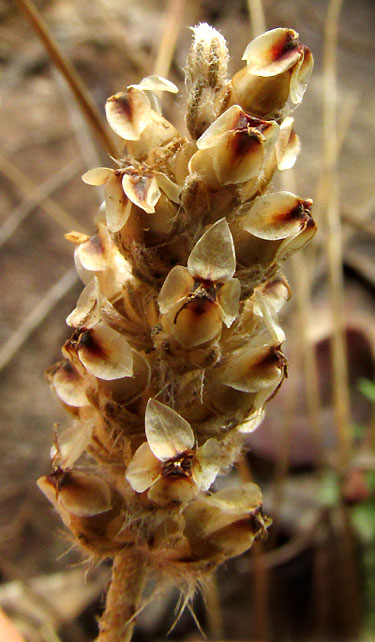Excerpts from Jim Conrad's
Naturalist Newsletter
entry from field notes dated July 3, 2022, taken on the eastern lower slope of Cerro de la Cruz, at an elevation of ~2700m (~8850 ft), just south of the community of El Pinar, Amealco de Bonfil, Querétaro, MÉXICO, (~N20.17°, ~W100.17°)
PLANTAGO NIVEA

At the edge of the oak forest mantling the steep, lower eastern slope of Cerro de la Cruz, where enough sunlight from the nearby open field entered for grass to shoot up amid the oak leaves, the above plantain was issuing an immature flowering head. Northerners who pay attention to plants in their neighborhoods will recognize this plant as a plantain because all of its leaves arise from the plant's base, and the flowers grow in tightly packed, elongate, spike-type clusters atop an erect stem, or scape. Up closer, the flowers show typical plantain features:

These blossoms are fading after they've been pollinated, but four wilted, brown-turning stamens can be seen dangling from the throat of each corolla. The flowers produce four green, hairy sepals and four widely spreading, thin, pale and somewhat transparent and papery corolla lobes, each lobe dark chestnut brown at its base. A more mature spike was present, a study in complementary brown hues:

Our plant is unmistakably a plantain, but it's a species with unusually narrow leaves bearing especially long hairs:

About 200 species of plantain, genus Plantago, are known worldwide, mainly occurring in the Temperate Zone. In our Bajío Region of upland central Mexico, which is cool enough to be considered temperate, six species have been documented. Of these six, only one species develops such slender leaves, less than 5mm wide (3/16 inch), and that's PLANTAGO NIVEA.
Plantago nivea has no English name, and in Spanish usually is known simply as llantén, a name applied to all plantain species. It occurs from upland northwestern Mexico south along the Western Sierra Madres into Guatemala. It's described as abundant in forests of oaks and pines, as well as pastured areas and along arroyos, at elevations of 1150-3400m (3500-11,200 ft).
This is yet another species introduced to science by Humboldt and Bonpland, who visited Mexico during 1803 and 1804. In 1817, the German botanist Gustav Kunze published the name Plantago nivea, along with the field notes of Humboldt and Bonpland. About this collection it was written, in Latin, "Crescit in Regno Mexicano prope Guanaxuato et fodinam Comimtis de Valenciana, alt. 1200 hex. Foret Septembri." -- "It grows in the Kingdom of Mexico near Guanajuato and Valenciana Mine, elevation 1200 meters. It flowers in September." Humboldt visited the mine on August 8, 1803.
In that same publication Kunze also described a collection he named Plantago xorullensis, which now is regarded as just a form of our Plantago nivea. This isn't surprising since Plantago nivea is a very variable species. Our plant, judging from pictures on the Internet, is particularly long-hairy. If the species nivea and the species xorullensis were inaugurated in the same publication, why was the name nivea given to the plants we have today? Because its description appeared closer to the top of the page than xorullensis, so it was the first name for our plant to be published, and thus has priority. By the way, the Latin nivea means "snow," and it's true that sometimes when lots of our plantain grow together, their flowers' stamens with their white filaments and cream-colored anthers extended, it's all fairly white.
For northerners in the tropics, the name "plantain" often is confusing. It's used not only for species of the genus Plantago but also for the big cooking bananas people like so much, as well as in the old days Europeans referred to sycamore trees, genus Platanus, as plantains.
Nothing special can be found about our plant's traditional "uses" for humans, other than that livestock don't mind eating it.